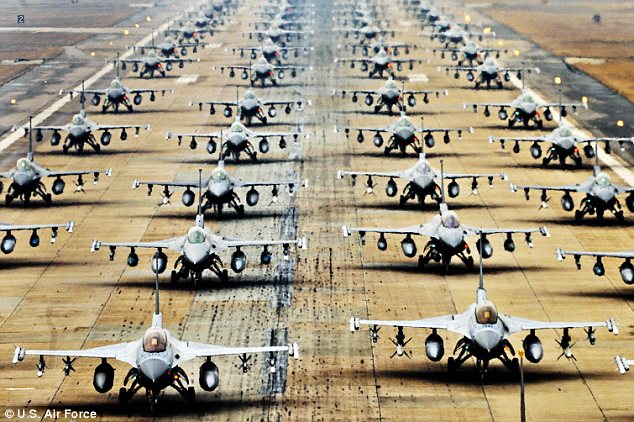US opts Russia’s way to update its Air Force: F-16 up-fitted instead of F-35 until 2040

Air Force F-16 gets F-35 sensors, weapons and radar
By Kris Osborn
File photo – An F-16 fighter from the U.S. Air Force 510th Fighter Squadron takes-off in Amari air base March 26, 2015.(REUTERS/Ints Kalnins)
The Air Force is giving its 1970s-era F-16 fighter F-35 technology as part of a massive fleet-wide overhaul intended to improve targeting, attack precision and computer systems — and extend the fighter’s combat life all the way into the 2040s.
A fleet of F-16s are now getting new F-35 Active Electronically Scanned radar, and other upgrades including upper wing skin and fittings, upper and lower bulkhead, and canopy sill longeron. The effort, called a Service Life Extension Program, is already underway; Low Rate Initial Production started last year, according to Capt. Hope Cronin, Air Force spokeswoman.
Current Air Force F-16s have flown roughly 6-to-7 thousand flight hours, en route to the original plan to fly the planes out to 8,000 hours. Now, however, the Air Force plan is to fly the jets all the way out to 12,000 hours, given the extent of the combat upgrades.
The SLEP program consists of 12 structural modifications and an existing Time Compliance Technical Order. The Air Force is upgrading 372 F-16 aircraft from the existing mechanically scanned radar (APG-68) to an Active Electronically Scanned Array (AESA) (APG-83), Cronin explained.
AIR FORCE CLOUD MIGRATION FIGHTS AI-ENABLED CYBERATTACKS
“This upgrade provides greater bandwidth, speed, & agility enabling F-16s to detect, track, & identify a greater number of targets, faster and at longer ranges,” she told Warrior Maven.
The new AESA radar can track up to 20-targets at one time, Randy Howard, Lockheed Martin F-16 Director of Strategy and Business Development, told Warrior Maven.
“The F-16 is a much more capable weapon due to the AESA radar. We are taking lessons learned from the F-35 and rolling them back into the F-16. The ASEA is able to see a wide area laterally, horizontally, diagonally and vertically,” he told Warrior Maven
Howard added that the upgraded F-16s are getting a modern, state of the art targeting system and sniper system along with clear graphics and video into the cockpit. “Pilots can see targets farther,” Howard said.
SUBMARINE SURGE: WHY THE NAVY PLANS 32 NEW ATTACK SUBS BY 2034
Alongside the Air Force SLEP, Lockheed Martin has also been building a new F-16v variant, which continues to inspire allied interest around the globe. The F-16v also uses new computers and software as well as a high-definition cockpit display. The “v” model also adds a new data bus, electronic warfare suite, missile warning sensor and helmet mounted cueing system.
The new F-16 also uses a high degree of increased onboard automation to free up pilot focus and workload. By automatically performing a range of important procedural functions independently, a pilot is then freed up to focus more intently on other mission-critical tasks.
“Instead of being a display manager, the pilot is a tactician…his systems are making self-protection decisions for him faster, at the speed of a computer,” Howard said.
Part of the F-16 automation includes the use of a computerized Ground Collision Avoidance System, a technology which uses computer algorithms to autonomously re-route the plane in the event that a pilot is incapacitated. The computer system can, for instance, take over flight of the plane to avoid a collision with the ground, building or other structure. So far, Air Force and Lockheed officials report that the program has already saved seven lives and billions in aircraft costs.
F-16 modernization is also part of a broader Department of Defense program to prototype AI-enabled predictive maintenance.
“The effort, which is using AI to analyze decades of maintenance records, will wrap up in late Summer 2019. It is progressing towards delivering a predictive maintenance application,” Cronin said.
The aims of the effort, which include using real-time analytics to anticipate potential points of failure, are to both improve mission effectiveness and lower sustainment, repair and maintenance costs. If a pilot knows in advance when an engine or onboard system may malfunction, he or she can adjust the mission accordingly.
The aims of the program, Cronin specified, are to “anticipate future unscheduled events, provide part-level inventory visibility and track cost and performance.
- Previous Jack Ma endorses China’s controversial 12 hours a day, 6 days a week work culture
- Next Bali, Maya Bay, Boracay, …., which is next to be wasted? Southeast Asia’s idyllic islands buckle under tourism strain










